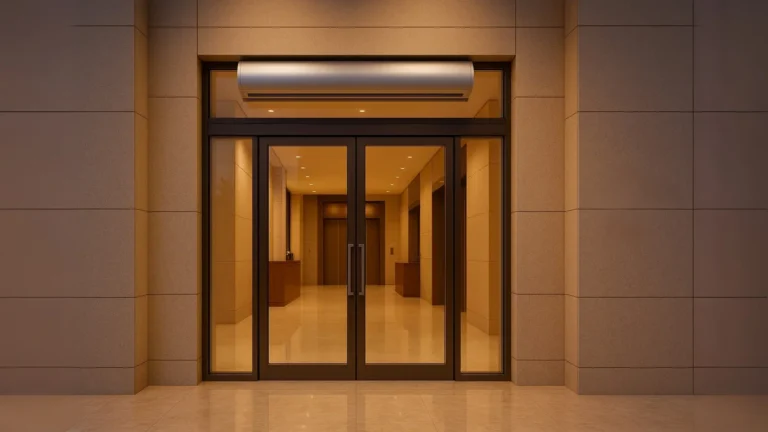
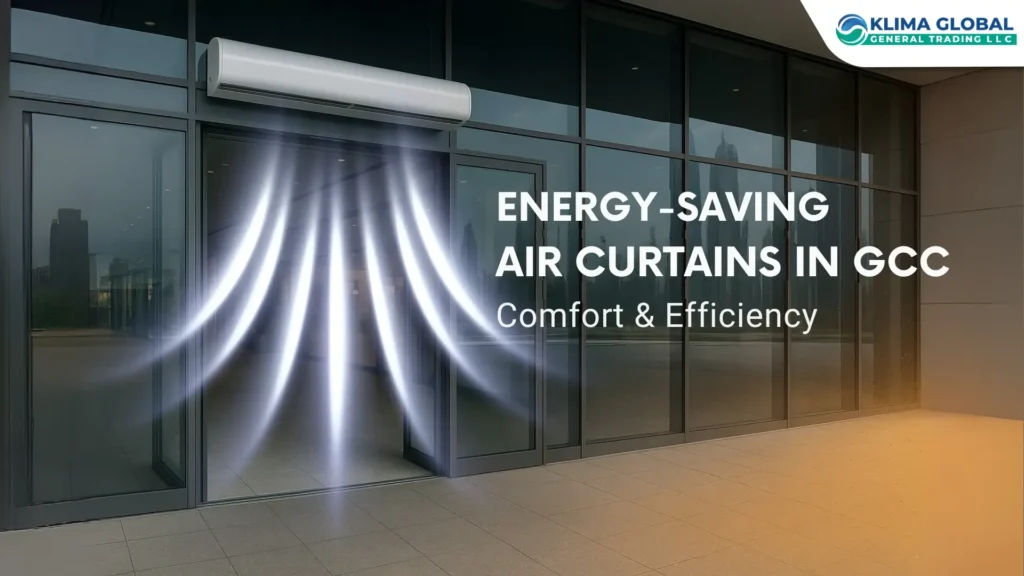
How Air Curtains Improve Comfort and Cut Energy Costs in GCC Buildings
Extreme heat and high energy bills are everyday challenges for businesses and facilities across the GCC. With outdoor temperatures often exceeding 45°C, HVAC systems work overtime to maintain indoor comfort—driving up electricity costs. This is where the energy saving air curtain becomes a game-changer. By forming an invisible barrier of high-velocity air at building entrances, air curtains keep cool air inside, block hot dusty air outside, and significantly reduce energy consumption.
In this article, we provide a comprehensive look at how energy-saving air curtains improve comfort, cut costs, and support sustainability goals across UAE, Saudi Arabia, and other GCC countries. We will explore technical functionality, cost benefits, environmental impact, and real-world applications, offering building managers, engineers, and decision-makers the insights needed to make informed choices.
The Energy Challenge in GCC Buildings
Cooling accounts for over 60–70% of total energy consumption in commercial and industrial buildings in the GCC. Shopping malls, hotels, offices, and warehouses spend millions annually on air conditioning. Frequent door openings at high-traffic entrances allow cooled indoor air to escape, while hot outdoor air rushes in—forcing HVAC systems to work harder and increasing utility bills.
The GCC faces three major challenges:
High Cooling Demand: Summer temperatures often exceed 45–50°C.
Rising Energy Tariffs: Increasing operational costs for facility owners.
Sustainability Regulations: Mandates from DEWA, Saudi Vision 2030, and regional building codes push businesses to adopt energy-efficient technologies.
This makes the adoption of energy-efficient solutions like air curtains not just desirable but essential.
How Energy Saving Air Curtains Work
An energy saving air curtain is installed above or beside doorways to blow a controlled stream of air across the entrance. This creates an invisible barrier that prevents air exchange between indoors and outdoors, allowing people and goods to move freely without compromising climate control.
Technical Advantages
Minimizes energy losses: Keeps conditioned air inside and hot outdoor air out.
Reduces HVAC load: Less strain on cooling systems lowers electricity consumption.
Improves air circulation: Ensures uniform comfort near entrances.
High efficiency performance: Modern models can save up to 90% of energy lost through uncontrolled infiltration.
For GCC businesses, this translates into significant cost savings, more reliable HVAC operations, and better working environments.
Comfort Benefits for Occupants
Energy saving air curtains don’t just save money—they also improve the overall indoor experience. The benefits extend beyond energy:
Stable Indoor Temperatures: Entrances remain comfortable even during peak summer hours.
Cleaner Indoor Air: Reduces dust, sand, and pollutants entering from outside.
Healthier Environments: Keeps insects, fumes, and odors away from sensitive areas.
Improved Guest Experience: Provides draft-free comfort in lobbies, restaurants, and retail spaces.
This is particularly valuable for shopping malls, hotels, restaurants, and healthcare facilities where comfort, hygiene, and customer experience are crucial.
ROI of Energy Saving Air Curtains in GCC
Investing in an energy saving air curtain is not just about savings—it is about quick returns and long-term value.
Payback Period: In UAE and Saudi Arabia, most businesses achieve ROI within 12–24 months through reduced electricity bills.
Reduced HVAC Maintenance: Lower wear and tear extends the lifespan of cooling systems.
Operational Efficiency: Optimized climate control improves staff productivity and guest satisfaction.
Long-Term Gains: Continued savings year after year, particularly in high-traffic facilities.
Many businesses report cost savings that more than justify the initial investment within the first few years.
Air Curtains as a Sustainability Solution
Energy saving air curtains are not just cost-cutting tools—they are sustainability enablers. Their impact aligns with GCC nations’ environmental and economic goals.
Carbon Reduction: Reduced HVAC demand translates into fewer CO₂ emissions.
Compliance with Green Standards: Supports LEED, Estidama, and other sustainability certifications.
Alignment with GCC Initiatives: Helps meet DEWA energy efficiency programs and Saudi Vision 2030 targets.
Sustainable Growth: Contributes to eco-friendly urban development and smarter building design.
By combining comfort with responsibility, air curtains help businesses meet both economic and environmental goals simultaneously.
Applications Across GCC Sectors
The versatility of the energy saving air curtain makes it suitable for multiple industries:
Retail & Shopping Malls: Maintain customer comfort and cut energy bills.
Hospitality & Hotels: Ensure welcoming lobbies without unpleasant drafts or high costs.
Industrial & Warehouses: Control temperature in loading bays, reducing HVAC losses from open doors.
Healthcare Facilities: Enhance infection control and create stable indoor environments.
Cold Storage: Prevent warm air infiltration, reduce condensation, and maintain food safety.
Airports & Transport Hubs: Manage massive traffic flow while maintaining indoor cooling.
Each sector benefits in terms of energy efficiency, comfort, and sustainability.
Why Choose Klima Global for Energy Saving Air Curtains
Klima Global is a trusted air curtain supplier in Dubai with extensive experience across the GCC. Our advantages include:
Comprehensive Product Range: Cross-flow and centrifugal models tailored to retail, industrial, and cold storage applications.
Energy-Efficient Designs: Every model is engineered to deliver maximum energy savings and quick ROI.
Local Expertise: Knowledge of GCC-specific climate challenges and building standards.
Proven Track Record: Successful installations in malls, hotels, warehouses, and healthcare facilities.
After-Sales Service: Dedicated support to ensure long-term performance.
Choosing Klima Global ensures businesses not only buy equipment but also gain a reliable partner for sustainable HVAC solutions.
Maintenance & Best Practices
Proper care ensures the energy saving air curtain continues to deliver peak performance:
Routine Cleaning: Filters, deflectors, and intake grills should be cleaned to maintain efficiency.
Performance Checks: Inspect motors and fans at scheduled intervals.
Correct Installation Height: Mounting at manufacturer-specified heights ensures maximum performance.
Service Agreements: Partnering with Klima Global ensures reliable servicing and optimal equipment life.
These practices reduce downtime, maintain energy efficiency, and maximize ROI.
Conclusion
The energy saving air curtain is more than just a doorway accessory—it is a strategic investment for businesses across the GCC. By reducing HVAC energy losses, improving occupant comfort, and supporting sustainability goals, air curtains deliver immediate as well as long-term value.
From malls in Dubai to warehouses in Riyadh, air curtains are helping businesses cut costs, meet regulatory standards, and improve customer experiences.
Looking to reduce cooling costs in UAE, Saudi Arabia, Oman, Qatar or the wider GCC? Contact Klima Global today for expert consultation and customized energy-saving air curtain solutions.
FAQs: Energy Saving Air Curtain
How exactly does an air curtain save energy in hot GCC climates?
By reducing infiltration—the unwanted exchange of outdoor air when doors open. A correctly sized air curtain maintains a coherent jet at the sill, cutting the amount of hot, dusty air that enters and the volume of conditioned air that escapes. This lowers sensible + latent cooling load on AHUs/RTUs and stabilizes lobby/FOH temperatures. The savings depend on door width, cycle rate, ΔT/ΔW (temperature/humidity difference), and run hours—so sizing and commissioning are critical.
What control strategy delivers the most kWh savings without hurting comfort?
Door-open interlock: Ramp to high only when doors open; run standby/low (or off) otherwise.
Speed staging (EC/VFD): Configure low/normal/boost profiles for traffic peaks and windy periods.
BMS integration: Expose run/stop, speed/setpoint, and fault points; align schedules with trading/visiting hours.
Pre-start & run-on: Short pre-start before doors fully open and a brief run-on after closing to stabilize the barrier.
Measurement culture: Log threshold velocity and installed dB(A) at commissioning; re-check quarterly.
What inputs do you need to estimate ROI for an Energy Saving Air Curtain?
Provide: door width/height, mounting height, door type & cycle rate (per hour), indoor/outdoor temperature & RH, operating hours, HVAC system type/efficiency (AHU/RTU, coil conditions), and electricity tariff. With these, we can model infiltration reduction and cooling-load impact to estimate kWh and cost savings. Multi-site portfolios (malls, hotels, supermarkets) often benefit from standardized assumptions and pilot measurements.
Do energy-saving settings reduce hygiene or entrance comfort?
Not if you hit the sill velocity target and commission correctly. For premium lobbies and offices, aim ~2.0–2.5 m/s at the floor; for QSR/retail with insect control or wind exposure, ~2.5–3.0 m/s. Start at 0–10° outward nozzle angle and tune on site so the jet reaches the floor without bounce-back or drafts. Properly staged speeds preserve comfort and reduce runtime.
What common mistakes kill energy savings—and how do we fix them fast?
No interlock/BMS schedule → always-high speed and high noise. Add door sensors + schedules immediately.
Undersized width vs door → edge leakage and lost barrier. Match unit width to clear opening.
Wrong type for height/wind → weak floor velocity. Use centrifugal units above ~3.5 m or in wind-exposed portals.
Starved intake (bulkheads/signage too close) → hiss/poor performance. Maintain soffit clearance.
No maintenance → dust-clogged grilles and drifting angles. Adopt monthly cleaning and quarterly velocity/dB(A) checks.
Get Customized Air Curtains for your Project!
Share this post
Related Posts

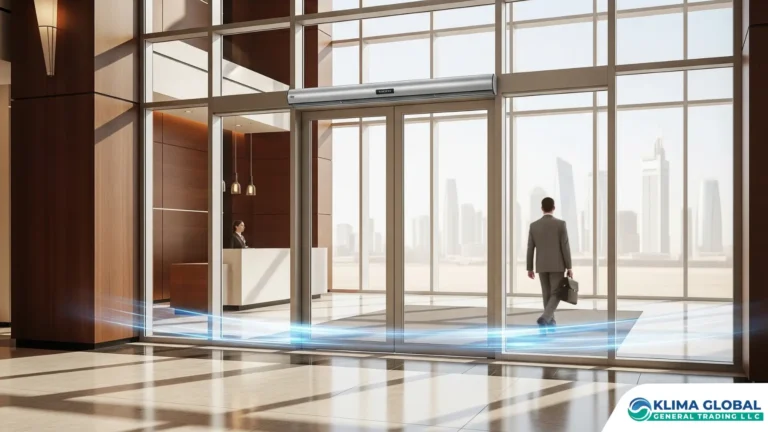
Best Air Curtain Supplier in Saudi Arabia | Buyer’s Guide
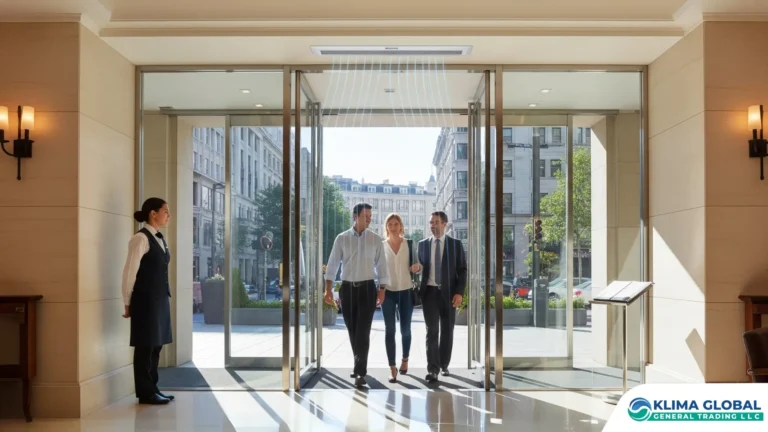
Low Noise Air Curtain | Silent Air Curtains for Hotels & Offices
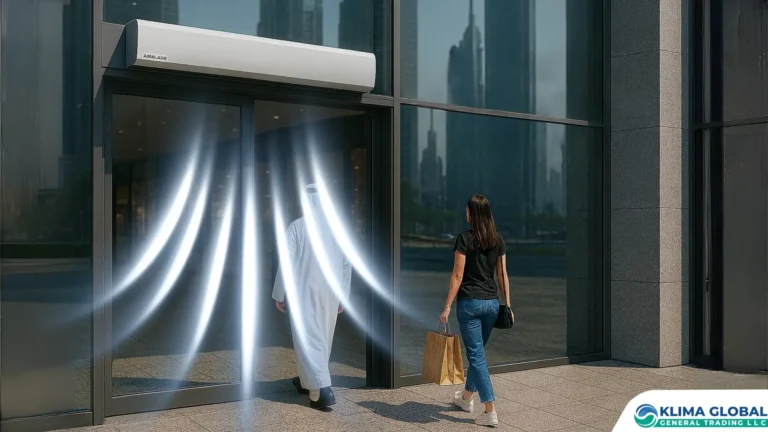
The Ultimate Guide to Air Curtains in the Middle East
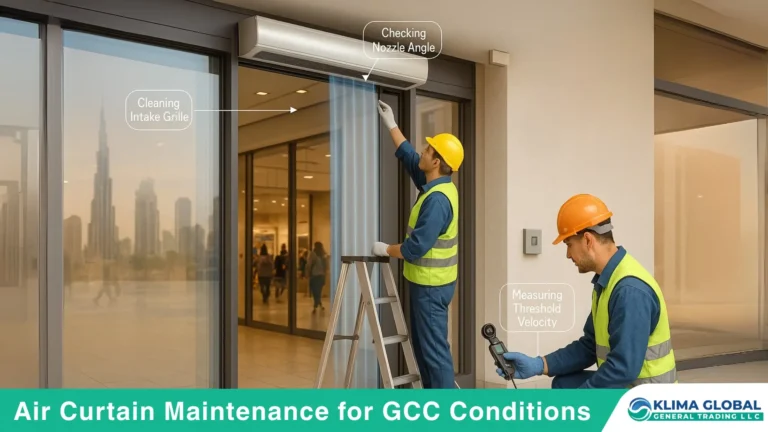
Air Curtain Maintenance Guide –Checklist, Service & Lifespan
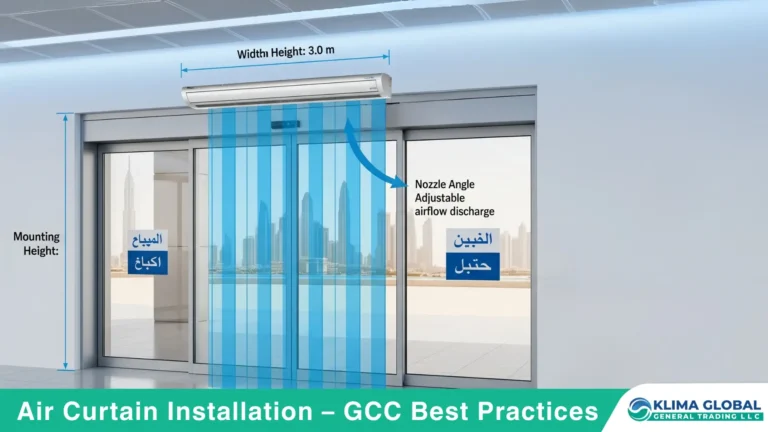
Air Curtain Installation Guide – Mounting, Sensors & BMS
Latest Posts

Best Air Curtain Supplier UAE | 2025 Buyer’s Guide

Best Air Curtain Supplier in Saudi Arabia | Buyer’s Guide

Low Noise Air Curtain | Silent Air Curtains for Hotels & Offices

The Ultimate Guide to Air Curtains in the Middle East

Air Curtain Maintenance Guide –Checklist, Service & Lifespan

Air Curtain Installation Guide – Mounting, Sensors & BMS
